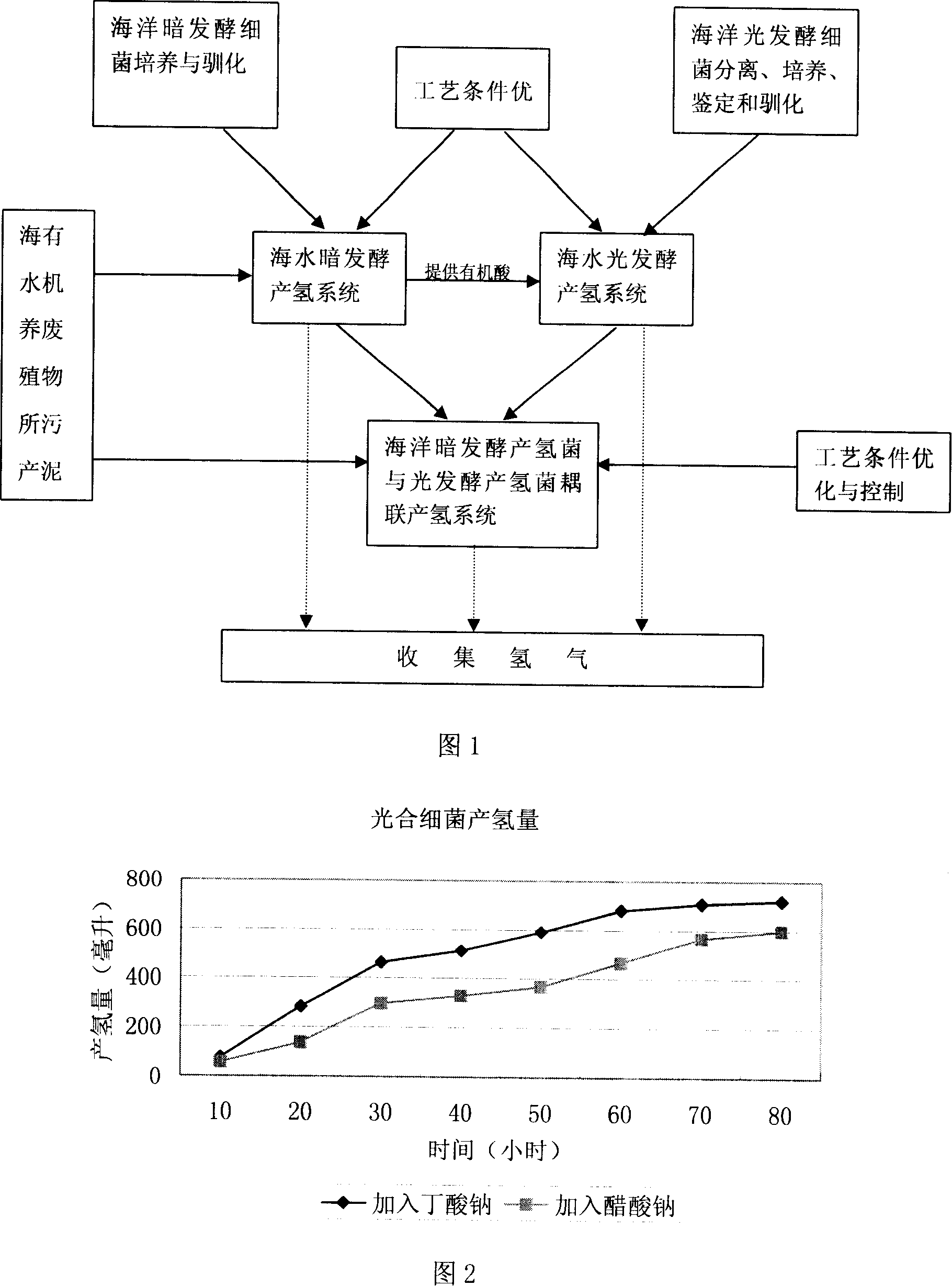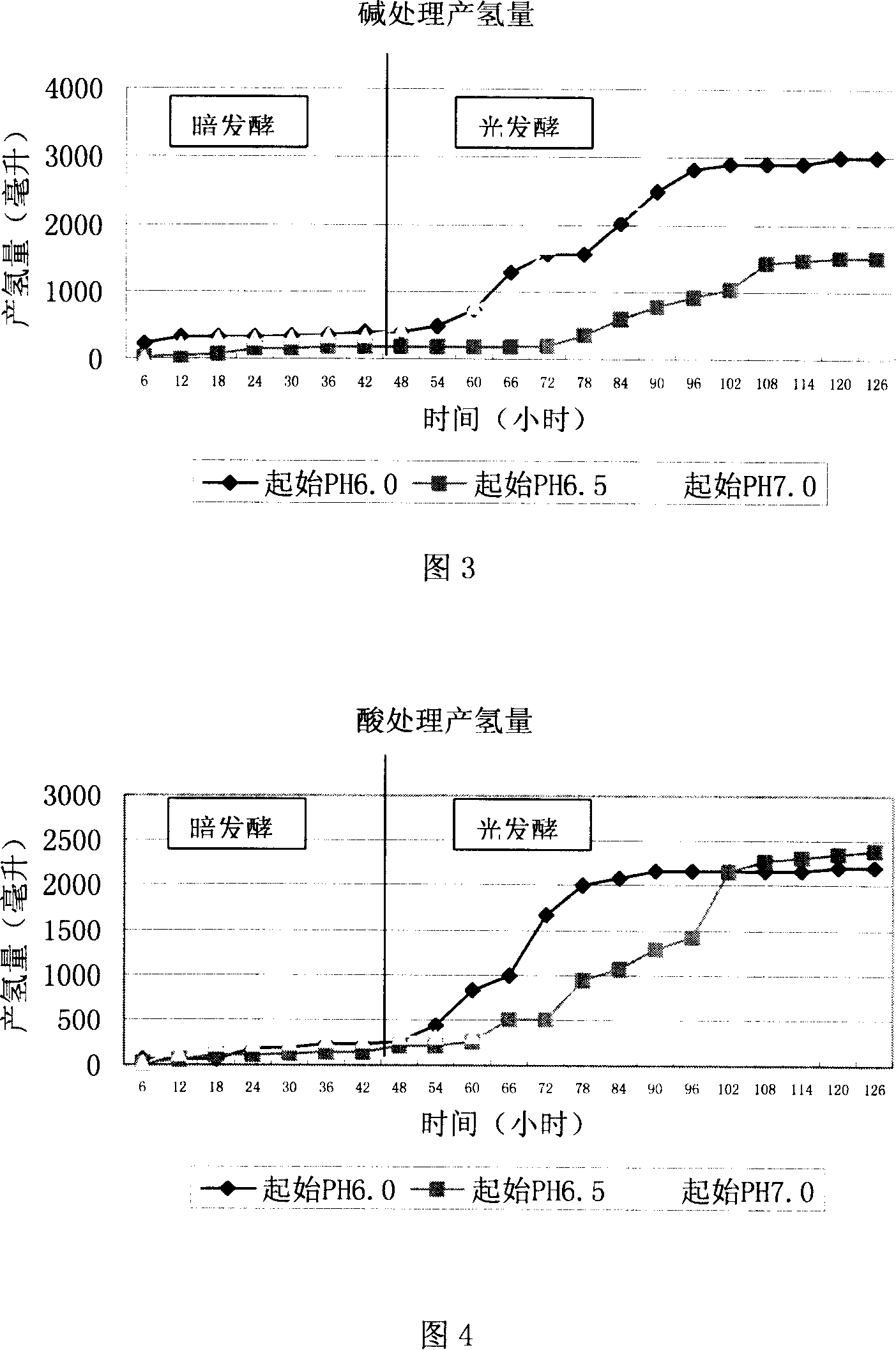Method for culturing marine photosynthetic bacteria used for light-dark fermentation and coupling hydrogen production
A technology of photosynthetic bacteria and photofermentation, which is applied in the marine field to achieve the effects of reducing costs, improving utilization, and reducing environmental pollution
- Summary
- Abstract
- Description
- Claims
- Application Information
AI Technical Summary
Problems solved by technology
Method used
Image
Examples
Embodiment 1
[0038] 1) Hydrogen production by photoculture (see Figure 1):
[0039] ① Enrichment culture: Take samples from the sludge of marine farms to cultivate marine photosynthetic bacteria. Immediately after sampling, add 50ml of the sample to 500ml of the screening medium designed by the applicant for enrichment culture, and fill the entire culture bottle as much as possible to Reduce the amount of air in the culture flask. Nitrogen gas was always blown to the sample during the whole operation, and nitrogen gas was blown to the culture bottle for 15 minutes before closing the rubber stopper of the culture bottle to achieve anaerobic culture conditions for 3 days. The culture conditions are as follows: the temperature of the incubator is 28° C., and the light intensity is 2500 lux. Wherein: the culture medium is a liquid culture medium and its components are: ammonium chloride 1.0g, sodium acetate 2.0g, yeast powder 0.2g, peptone 0.1, sodium bicarbonate 1, seawater 1000ml, pH 7.5; t...
Embodiment 2
[0053] The difference from Example 1 is:
[0054] 1) Photoculture hydrogen production:
[0055] ①Enrichment culture: Take samples from the sludge of marine farms to cultivate marine photosynthetic bacteria. Immediately after sampling, add 40ml of the sample to 400ml of the screening medium designed by the applicant for enrichment culture, and cultivate in anaerobic conditions for 4 days. The conditions are: the temperature of the incubator is 35° C., and the light intensity is 2500 lux. Wherein: the culture medium is liquid culture medium composition is: ammonium chloride 2.0g, sodium acetate 4.0g, yeast powder 1.0g, peptone 0.5g, sodium bicarbonate 2g, seawater 1000ml, pH8.2; Then repeat above-mentioned enrichment culture 3 The next time, the enriched medium turns red or purple, and Rhodoseudomonas capsulata and Rhodobacter sphaeroides appear.
[0056] ②Hydrogen production culture: Streak the inoculum after the enrichment culture to pick a single colony. The medium at this ...
Embodiment 3
[0064] The difference from Example 1 is:
[0065] 1) Photoculture hydrogen production:
[0066] ①Enrichment culture: Immediately after sampling, 15ml of the sample was added to 60ml of the screening medium designed by the applicant, and the enrichment culture was cultured under anaerobic conditions for 4 days. The culture conditions were: the temperature of the incubator was 30°C, and the light intensity was 3500 lux. Wherein: medium is liquid medium composition and is: ammonium chloride 4.5g, sodium acetate 2.5g, yeast powder 0.5g, peptone 0.5g, sodium bicarbonate 1.5g, seawater 1000ml, pH 7.8; Then repeat above-mentioned enrichment culture 3 Second, the enriched medium turns red or purplish red, Rhodoseudomonas capsulata, Rhodobacter sphaeroides.
[0067] ②Hydrogen production culture: Streak the inoculum after the enrichment culture to pick a single colony. The medium at this time is 1.8 grams of agar added to the hydrogen production medium. The culture conditions: add 1.5 ...
PUM
 Login to View More
Login to View More Abstract
Description
Claims
Application Information
 Login to View More
Login to View More - R&D
- Intellectual Property
- Life Sciences
- Materials
- Tech Scout
- Unparalleled Data Quality
- Higher Quality Content
- 60% Fewer Hallucinations
Browse by: Latest US Patents, China's latest patents, Technical Efficacy Thesaurus, Application Domain, Technology Topic, Popular Technical Reports.
© 2025 PatSnap. All rights reserved.Legal|Privacy policy|Modern Slavery Act Transparency Statement|Sitemap|About US| Contact US: help@patsnap.com


